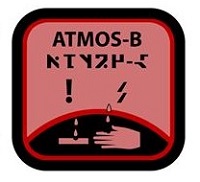Corrosive Atmosphere
A Corrosive Atmosphere is a type of atmosphere known for possessing a concentrated gas mix or unusual temperature creates a corrosive environment, which requires the use of a Hostile Environment Suit or Vacc Suit.
Description (Specifications)[edit]
Corrosive atmospheres require the use of protective suits or vacc suits to insulate the wearer from harm. Several of the exotic atmospheres classified as irritant are, in fact, mild forms of corrosive atmospheres. The chief difference between the two lies in the degree of danger posed by the atmosphere — irritants cause only minor damage, while true corrosive atmospheres kill unprotected humans in a short time. [1]
Extreme Atmospheres[edit]
Extreme Atmospheres: Some of the more difficult atmosphere types to explain and describe are the 'extremes', types A, B and C which equate to Exotic, Corrosive and Insidious.
- Whereas the Very Thin, Thin, Standard and Dense atmospheres are generally Earth-like in pressures with Earth-like gasses (Nitrogen-Oxygen-Carbon Dioxide mixtures) in a variety of amounts, the 'extremes' are terribly toxic, horribly lethal and utterly alien.
- The three types are really grades of lethality, and an A type and C type atmosphere may actually contain the same poisonous gas, just in different amounts. [2]
Lethality of Extreme Atmospheres Atmo. Code Class Name Danger Remarks A Exotic, Conventional Exotic Atmosphere DANGEROUS A gaseous mixture, which is unbreathable by mainline conventional life sophonts. B Exotic, Conventional Corrosive Atmosphere HIGHLY DANGEROUS Not only a dangerous gaseous mixture, but may have dangerous pressure, an temperature qualities in addition to corrosive (acidic) properties. C Exotic, Conventional Insidious Atmosphere EXTREMELY DANGEROUS Even more dangerous than a Corrosive Atmosphere, with persistently lethal properties that will kill most mainstream sophonts within minutes and destroy most protective equipment within two to twelve hours. D, E, F Exotic, Unusual Unusual Atmosphere DANGEROUS Unusual Atmospheres have livable respiration zones, typically at the heights or depths of a topography. They are rare worlds with very unconventional atmospheres such as Ellipsoid Worlds.
Basic Exotic-Extreme Atmosphere Types[edit]
- Extreme Low Temperature
- Very Thin, Low Temperature
- Very Thin, Moderate Temperature
- Very Thin, High Temperature
- Thin/Standard/Dense, Low Temperature
- Thin/Standard/Dense, Moderate Temperature
- Thin/Standard/Dense, High Temperature
- Very Dense, Low Temperature
- Very Dense, Moderate Temperature
- Very Dense, High Temperature
- Extreme High Temperature
Common Corrosive Atmospheric Components[edit]
Gasses which give an atmosphere an extreme label include carbon dioxide, methane, nitrogen, sulphur, oxygen, hydrogen, ammonia, chlorine and fluorine. These gases are often found in combination with others on the list potentially mixing together with additional dangerous effects into one nasty airborne cocktail! [3]
History & Background (Dossier)[edit]
Corrosive (B): Corrosive atmospheres are highly dangerous. A sophont who breathes in a corrosive atmosphere will suffer damage every few minutes until death occurs. [4]
Selective Corrosive Atmosphere Types[edit]
- Ammonia (NH3): An irritant at best, atmospheres containing high concentrations of ammonia become corrosive. Usually characteristic of low temperatures. [5]
- Chlorine (Cl2): More active, more poisonous, and more irritating to exposed skin than ammonia, chlorine in the atmosphere will be corrosive in any but the mildest concentrations. [6]
- Fluorine (F2): Similar in nature to chlorine, fluorine in an atmosphere is even more irritating, even in small quantities. Atmospheres containing fluorine are always considered corrosive at best. Fluorine shares many properties with chlorine, including the possibility of supporting completely alien forms of life. It is easily detected by smell and by color, but quickly lethal if a major leak occurs. [7]
- Nitrogen (N2): A world in which free oxygen and nitrogen exist together in the acid and the presence of nitrides (nitrogen-oxygen compounds) in the atmosphere cause it to become most dangerous for unprotected humans. [8]
- Sulfur Compounds: The presence of sulfur compounds in sufficient concentrations will be corrosive, and can cause damage to unprotected individuals. [9]
References & Contributors (Sources)[edit]
- Marc Miller. Worlds and Adventures (Game Designers Workshop, 1977), 5.
- J. Andrew Keith. Exotic Atmospheres (Game Designers Workshop, 1983), 1-16. (Special Supplement 2 from the periodical Journal of the Travellers' Aid Society 17)
- Marc Miller. Referee's Manual (Game Designers Workshop, 1987), 22.
- Geir Lanesskog. World Builder's Handbook (Mongoose Publishing, 2023), 64-68.Joe Fugate, J. Andrew Keith, Gary L. Thomas. World Builder's Handbook (Digest Group Publications, 1989), 64-68.
- Terrance McInnes, Dave Nilsen. World Tamer's Handbook (Game Designers Workshop, 1994), 11-17.
- Jon F. Zeigler. First In (Steve Jackson Games, 1999), 70,72.
- Paul Drye, Loren Wiseman, Jon F. Zeigler. Interstellar Wars (Steve Jackson Games, 2006), 125-6.
- Gareth Hanrahan. Core Rulebook (Mongoose Publishing, 2008), TBD.
- Marc Miller. T5 Core Rules (Far Future Enterprises, 2013), 409.
- Paul Elliott. The Universal World Profile (Zozer Games, 2016), TBD.
- Matthew Sprange. "Exotic Atmospheres." Journal of the Travellers' Aid Society volume 2 (2019): 60-69.
- ↑ J. Andrew Keith. Exotic Atmospheres (Game Designers Workshop, 1983), 7-8.
- ↑ Paul Elliott. The Universal World Profile (Zozer Games, 2016), 16.
- ↑ Paul Elliott. The Universal World Profile (Zozer Games, 2016), 16.
- ↑ Gareth Hanrahan. Core Rulebook (Mongoose Publishing, 2008), 170.
- ↑ J. Andrew Keith. Exotic Atmospheres (Game Designers Workshop, 1983), 8.
- ↑ J. Andrew Keith. Exotic Atmospheres (Game Designers Workshop, 1983), 8.
- ↑ J. Andrew Keith. Exotic Atmospheres (Game Designers Workshop, 1983), 8.
- ↑ J. Andrew Keith. Exotic Atmospheres (Game Designers Workshop, 1983), 8.
- ↑ J. Andrew Keith. Exotic Atmospheres (Game Designers Workshop, 1983), 8.
